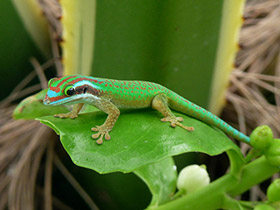 The gecko, a small, harmless lizard that lives in tropical regions, possesses a characteristic which distinguishes it from other lizards. It can walk on walls, or even ceilings, as easily as if walking on the ground. It can even run upside down on varnished surfaces. ("Geckos Climb by the Hairs of Their Toes", Elizabeth Pennisi, Science magazine, June 30, 2000)
The gecko, a small, harmless lizard that lives in tropical regions, possesses a characteristic which distinguishes it from other lizards. It can walk on walls, or even ceilings, as easily as if walking on the ground. It can even run upside down on varnished surfaces. ("Geckos Climb by the Hairs of Their Toes", Elizabeth Pennisi, Science magazine, June 30, 2000)
What is this system that permits the gecko's feet to cling so tightly to the surface and move so astonishingly?
The gecko does not cling to the ceiling by secreting an adhesive substance, since the lizard has no glands with which to do such a thing. Furthermore, such a system might also stick the gecko to a surface, but not allow it to move.
Nor does the reptile's ability stem from a structure like a suction cup. The gecko's feet also work perfectly in a vacuum, and a suction cup cannot attach itself to the ceiling in such an environment.
Neither is there any question of electrostatic attraction. Experiments have proven that the gecko's feet function even in ion-charged air. Were electrostatic attraction being used, the ions added to the air diminish the force of attraction and prevent the lizard holding on.
Research has shown that the mechanism in the gecko's feet is an example of superior engineering. In fact, the lizard's entire foot has been designed for climbing.
The tips of the gecko's toes are covered with thin leaves of skin, just like the pages of a book. Every leaf, in turn, is covered in a special tissue known as setae, hair-like protuberances, whose ends are divided into thousands of microscopic tips.
On the gecko's toe, an area the size of a pinhead contains an average of 5,000 micro-hairs. That means each of the animal's feet contains around half a million hairs.
Every single hair consists of between 400 and 1,000 protrusions, all located in such a way as to face the animal's heels. The tip of each one is about 5,000th of a millimeter thick. The millions of microscopic tips on the gecko's feet use the gravitational force of the atoms in the surface it walks on to firmly adhere to that surface.
As the gecko walks, it places the soles of its feet on the surface and pulls them slightly backwards, ensuring maximum contact between the hairs and the surface. Its hairs cling tightly to microscopic protrusions and cavities on the surface, too small to be seen with the naked eye. Thus on the molecular level, a slight gravitational attraction forms between the foot and the surface, known as the Van der Waals Force in quantum physics. ("Bonding", www.ider.herts.ac.ukschool/courseware/materials/bonding.html)
This force is also present when you place your hand on the wall, but it is very weak. If you were to view your hand at the atomic level, you would see that its surface is covered in tiny crests, and only the few atoms at the tops of these crests make actual contact with the wall. However, the thousands of spatulate tips on the gecko's feet stick to the wall with greater force.
If the gecko's toes really were covered with an adhesive (or with suction caps, as scientists once believed) then every time it lifted its feet the lizard would have to expend considerable energy to break that adhesion. According to the findings of the research team, however, in order for the gecko to lift its feet, it needs only to change the angle at which it makes contact with the wall.
The position and concentration of the micro-hairs on the gecko's feet give rise to the Van der Waals Force, which overcomes the force of gravity. When it wishes to take another step, the reptile bends the sole of its foot forward and raises it by expending a greater molecular force than that of gravity.
Clearly, the number and angle of the hairs on the creature's feet are based on sensitive engineering. Were the density of the hairs any greater, the animal would stick to the ceiling; any less, or if the hairs were located at a different angle, it would fall off.
Yet such a thing never happens. The density of the hairs that give rise to the Van der Waals force is exactly right.
If a gecko that had 2,000 hairs per square millimeter instead of 2 million, an insufficient Van der Waals force would form, and it would fall off as it attempted to walk on the ceiling. The existence of the whole elaborate hair structure would be to no avail.


